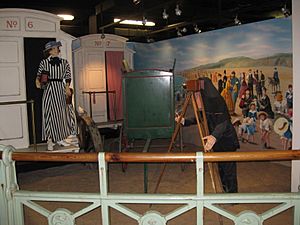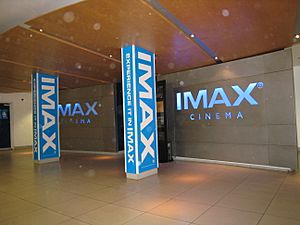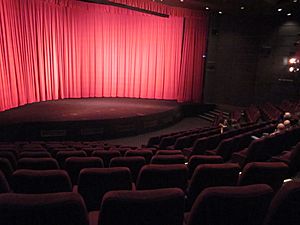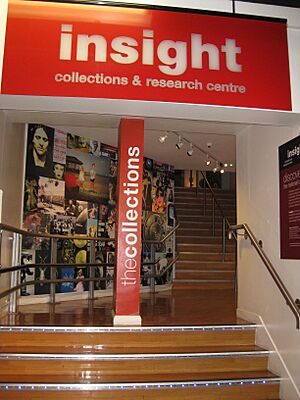National Science and Media Museum facts for kids

National Science and Media Museum with statue of J. B. Priestley
|
|
| Former name | National Media Museum National Museum of Photography, Film and Television |
|---|---|
| Established | 16 June 1983 |
| Location | Bradford, West Yorkshire, England |
| Collections | National Photography Collection, National Cinematography Collection, National Television Collection, National New Media Collection |
| Collection size | 3.5 million items |
| Visitors | 439,916 (2019) |
| National Museum of Science and Industry | |
| National Media Museum · National Railway Museum (Shildon Locomotion Museum) · Science Museum (Dana Centre, Science Museum Swindon) | |
The National Science and Media Museum is a cool place in Bradford, West Yorkshire, England. It's part of the national Science Museum Group in the UK. The museum has seven floors of galleries. These galleries show off amazing things about photography, television, animation, videogaming, the Internet, and how light and colour work.
The museum also has special temporary exhibitions. It keeps a huge collection of 3.5 million items for research. It has three cinemas, including Europe's first IMAX screen, which opened in 1983. The museum hosts fun festivals about films, video games, and science.
In 2011, people voted the museum the best indoor attraction in Yorkshire. It's one of the most visited museums in northern England. In 2017, its name changed from National Media Museum to National Science and Media Museum. The museum temporarily closed in July 2023 for big updates. It reopened to visitors in January 2025 with two brand new galleries.
Contents
Visiting the Museum
It's free to enter the museum, but you need to buy tickets for the cinema shows. The museum is usually open from 10 am to 6 pm every day. In 1998, the museum had a big £16 million makeover. This added a new digital technology gallery and a cool glass-fronted area with a café and shop.
Explore the Galleries
The museum has several exciting permanent exhibitions:
- Kodak Gallery – This gallery takes you on a trip through the history of popular photography. You can see everything from the very first photos to today's digital pictures. Most items come from the museum's collection of 35,000 objects donated by Kodak.
- Wonderlab – This interactive gallery lets you explore light and sound. You can try out hands-on exhibits and watch live experiments. It opened in 2016.
- BFI Mediatheque – Here, you can watch films and TV shows from the British Film Institute collection. It includes a special selection called TV Heaven.
- Games Lounge – Get ready to play classic video games on their original arcade machines or consoles! You can also learn about the history of video gaming and how it became a global hit.
- Sound and Vision – These are new galleries that opened in 2025.
Amazing Cinemas
The museum has the first permanent IMAX cinema in the UK. It opened in 1983. Films like Apollo 13, The Lion King, and Harry Potter and the Goblet of Fire were shown here. In 1999, the IMAX started showing 3D movies. The projection system was updated to digital in 2015.
The museum also has the Pictureville Cinema. It opened in 1992 and is known for its amazing sound and picture quality. It shows all kinds of films, from old 70mm movies to new digital ones. Pictureville is one of only three public cinemas in the world that can show original 3-strip 35mm Cinerama films.
The Cubby Broccoli Cinema is another cinema with 106 seats. It's named after the producer of the James Bond films.
Insight Centre
The Insight centre is a special place where you can see parts of the museum's collections that are not usually on display. You need to book a visit in advance.
Museum Collections
The museum has 3.5 million items that are important for history, culture, and society. Some cool things in the collection include:
- The very first photographic negative.
- The earliest television footage ever recorded.
- The world's first colour moving pictures.
- Louis Le Prince's 1888 films Roundhay Garden Scene and Traffic Crossing Leeds Bridge.
- A collection of 35,000 objects and images from Kodak.
- About 1,000 historical items from the BBC.
- The huge photo archive of the Daily Herald newspaper.
- Original toys from the BBC series Play School.
- Objects and designs used to make Hammer horror films.
You can see these collections at the museum's Insight study centre. The collection of the Royal Photographic Society was moved to the museum in 2003. However, most of it moved to the Victoria and Albert museum in London in 2017. The National Science and Media Museum kept items that show how photography developed, like the Kodak collection, and things important to Bradford.
Museum History
National Museum of Photography, Film and Television
The museum opened on June 16, 1983. It was built on a site in Bradford that was originally meant for a theatre. The Science Museum, London and Bradford's city leaders worked together to create the National Museum of Photography, Film and Television.
The original theatre building was changed to fit the museum. Its main feature was the auditorium with the IMAX cinema, which had the largest cinema screen in Britain at the time. The museum focused on the art and science of images.
In 1986, two interactive television galleries were added. Visitors could use cameras, vision mixers, and read news from an autocue. In 1989, the Kodak Gallery opened, showing the history of photography. Later, a real television studio was added, which was used for live broadcasts. These were the first live broadcasting studios in a museum.
The museum closed for 19 months in 1997 for a big £16 million renovation. It reopened on June 16, 1999, and the IMAX cinema could now show 3D films.
National Media Museum
On December 1, 2006, the museum changed its name to the National Media Museum. Two new interactive galleries opened: Experience TV (now Wonderlab) and TV Heaven (now BFI Mediatheque). These galleries showed the past, present, and future of television. They included scientific exhibits and fun items like a Wallace and Gromit film set and Play School toys.
In 2009, Bradford became the world's first UNESCO City of Film, thanks to the museum and other local groups.
In 2010, the museum added a new Games Lounge. This gallery, which became permanent, showed the history of video gaming. In 2012, the museum opened Life Online, the world's first gallery about the social and cultural impact of the Internet.
In 2014, the museum partnered with Picturehouse Cinemas to run its three cinema screens. However, the museum later stopped its film festivals, which caused some debate. In 2016, the Experience TV gallery closed to make way for the new Wonderlab.
National Science and Media Museum
In March 2017, the museum opened its new £1.8 million interactive gallery, Wonderlab. It also announced its second name change, becoming the National Science and Media Museum. Wonderlab explores light and sound with cool attractions like a mirror maze and a musical laser tunnel.
In August 2017, The Magic Factory exhibition closed. Its space was turned into a new activity and picnic area called Makespace. In September 2017, Soyuz TMA-19M, the space capsule that brought British astronaut Tim Peake back to Earth, was displayed at the museum.
In April 2018, the museum reported a big increase in visitors. In September 2019, the museum ended its partnership with Picturehouse Cinemas and started running its cinemas independently again under the name Pictureville.
The museum temporarily closed on June 5, 2023, for a major refurbishment. Life Online was updated, and the TV Gallery and Animation Gallery were redeveloped into the new Sound and Vision Galleries. The museum reopened in January 2025.
Current Festivals
Widescreen Weekend
This film festival happens every October. It focuses on large-screen film formats and cinema technologies. It includes screenings of 70mm and Cinerama films.
Yorkshire Games Festival
This video game festival started in 2016. It celebrates game culture, design, and how games are made. It includes talks and events for families.
Bradford Science Festival
This family science festival was first held in 2012. The museum took over running it in 2017, working with the University of Bradford, Bradford Council, and Bradford College.
Past Exhibitions
- Ooh La La! Martin Parr, 1998
- Donovan Wylie: Losing Ground, 1998
- Young Meteors: British Photojournalism 1957–1965, 1998
- ReVisions: An Alternative History of Photography, 1999
- New Natural History, 1999
- Birth of the Cool: David Bailey, 1999–2000
- FutureWorld, 2000
- A Collector's Choice, 2000
- Specimens and Marvels: The Work of William Henry Fox Talbot, 2000
- NOISEGATE by Granular Synthesis, 2000
- The Art of Star Wars, 2000–2001
- In a Lonely Place, 2001
- Symptomatic: Recent Works by Perry Hoberman, 2001
- Paul Strand: Tir a'Mhurain, 2001–2002
- Bond, James Bond, 2002
- Martin Parr: Photographic Works 1971–2000, 2002–2003
- Unknown Pleasures: Unwrapping the Royal Photographic Society Collection, 2003
- Fabula, 2003
- Julia Margaret Cameron: 19th Century Photographer of Genius, 2003
- GENUS, 2003–2004
- A Matter of Focus: The Art of Photography 1892–1917, 2003–2004
- Luc Delahaye: History and Winterreise, 2004
- Simone Nieweg: Landscapes and Gardens, 2004
- Everything's Gone Green: Photography and the Garden, 2004
- Faking It: Between Art Photography and Advertising, 2004
- A Gentle Madness: The Photographs of Tony Ray-Jones (1941–1972), 2004–2005
- The Other Side of Football: Hans van der Meer, 2005
- Forget Me Not: Photography and Remembrance, 2005
- Fashination, 2005
- Lifetimes: Portrait Projects by Julian Germain, 2005–2006
- Raghubir Singh: From One World to Another, 2005–2006
- Mark Power: A System of Edges, 2006
- Elliot Erwitt: A Retrospective, 2006
- A Tale of Two Cities, 2006
- Myths and Visions: The Art of Ray Harryhausen, 2006
- The British Landscape: Photographs by John Davies, 2006–2007
- The Old Order and the New: P.H. Emerson and Photography (1885–1895), 2006–2007
- Paul Seawright: Field Notes, 2007
- An-My Lê: Small Wars, 2007
- The Dawn of Colour: Celebrating the Centenary of the Autochrome, 2007
- Celebrating Indian Cinema, 2007
- Extra! Extra! Tales from the Daily Herald Picture Library, 2007
- Sarah Jones, 2007–2008
- Henri Cartier-Bresson's Scrapbook: Photographs 1932–1946, 2007
- Sunny Snaps, 2007
- Live By the Lens, Die By the Lens, 2008
- New Works: Pavilion Commissions 2008, 2008–2009
- Breaking News: Celebrating 140 Years of the Press Association, 2008–2009
- "Here's one we made earlier..." 50 Years of Blue Peter, 2008–2009
- Baby: Picturing the Ideal Human, 2009
- Don McCullin: In England, 2009
- Animalism, 2009
- Drawings That Move: The Art of Joanna Quinn, 2009–2010
- Neeta Madahar, 2009–2010
- Robbie Cooper: Immersion, 2010
- Simon Roberts: We English, 2010
- Fay Godwin: Land Revisited, 2010–2011
- From Back Home, 2010–2011
- The Lives of Great Photographers, 2011
- David Spero: Churches, 2011
- Daniel Meadows: Early Photographic Works, 2011–2012
- Outposts: Donovan Wylie, 2011–2012
- In the Blink of an Eye, 2012
- Art of Arrangement: Photography and the Still Life Tradition, 2012–2013
- [open source]: Is the internet you know under threat?, 2012–2013
- Moving Stories: Children's Books from Page to Screen, 2013
- Bollywood Icons −100 Years of Indian Cinema, 2013
- Tom Wood: Photographs 1973–2013, 2013
- Copper Horses by Chris Harrison, 2013–2014
- Doctor Who and Me, 2013–2014
- Nature, Camera, Action!, 2014
- Open for Business, 2014
- Only in England: Photographs by Tony Ray-Jones and Martin Parr, 2014
- Joan Fontcuberta: Stranger than Fiction, 2014–2015
- Light Fantastic: Adventures in the Science of Light, 2015
- Drawn by Light: The Royal Photographic Society Collection, 2015
- Revelations: Experiments in Photography, 2015–2016
- Star Wars: The Fans Awaken, 2015–2016
- Great Interactions: Photographs by Polly Braden, 2016
- Gathered Leaves: Photographs by Alec Soth, 2016
- In Your Face, 2016
- El Salvador: Between Revolution and War, 2016
- Fox Talbot: Dawn of the Photograph, 2016–2017
- Britain in Focus: A Photographic History, 2017
- Poetics of Light: Pinhole Photography, 2017
- Supersenses, 2017
- Soyuz TMA-19M: Tim Peake's Spacecraft, 2017
- Fake News, 2017–2018
- City Girls, 2017–2018
- Thresholds and Immersion, 2018
- Action Replay, 2018–2019
- Never Alone, 2018–2019
- Above the Noise: 15 Stories from Bradford, 2019
- Gaia by Luke Jerram, 2019
Discontinued Film Festivals
The museum used to organize four major film events each year. These included the Bradford International Film Festival and the Bradford Animation Festival. All four festivals were eventually stopped by the museum.
Bradford International Film Festival
This festival started in 1995. It showed new and classic films from all over the world. It aimed to help people understand the art and science of moving images. The festival also featured the Shine Awards for new European directors.
Bradford Animation Festival
This festival was the UK's top event for animation and video games. It included discussions, workshops, and special events. The annual BAF Awards celebrated new animation from around the world. Famous studios like Pixar and Aardman attended. The museum stopped this festival after its 20th edition in 2014.
Fantastic Films Weekend
This festival began in 2002. It focused on classic ghost stories and supernatural themes. It grew into an annual celebration of horror, fantasy, and sci-fi films and TV. The festival ended in 2013.
The Co-operative Film Festival
The Co-operative Film Festival started in 1966. It was a non-competitive festival that encouraged young people to be creative with film. The museum hosted this festival from 1999 until it ended in 2013.
Notable Staff
- Colin Ford, first Head of Museum, 1983–1993.
- Amanda Nevill, Head of Museum, 1994–2003.
See also
 In Spanish: National Science and Media Museum para niños
In Spanish: National Science and Media Museum para niños






